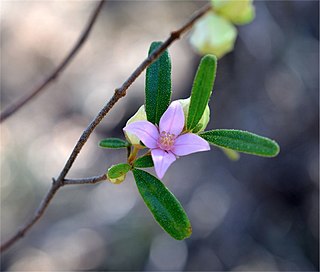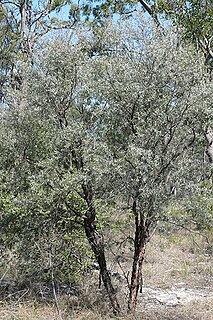
Triplarina is a genus of seven species of flowering plants in the family Myrtaceae. They are Baeckea-like shrubs with small leaves arranged in opposite pairs and flowers with five sepals, five more or less round petals, and fourteen to eighteen stamens that are shorter than the petals. Species of Triplarina occur in New South Wales and Queensland usually growing in woodland or forest.
Zieria distans is a plant in the citrus family Rutaceae and is only found on a few isolated mountains in Queensland. It is a straggly shrub with wiry branches, warty, three-part leaves and clusters of up to about twenty small white flowers, each with four petals and four stamens, in the leaf axils.
Zieria exsul is a plant in the citrus family Rutaceae and is endemic to a small area of southeast Queensland. It is an open, straggly shrub with hairy branches, three-part leaves and white flowers in groups of up to twelve, the groups longer than the leaves and each flower with four petals and four stamens.
Zieria graniticola is a plant in the citrus family Rutaceae and is a dense, compact shrub with erect wiry branches, three-part leaves and pale pink flowers in groups of up to three, each with four petals and four stamens. It is only known from two population near Stanthorpe in Queensland, Australia.
Zieria hydroscopica is a plant in the citrus family Rutaceae and is only known from a single state forest near Monto in Queensland. It is a small shrub with erect, wiry branches, three-part leaves and groups of large numbers of flowers, the groups smaller than the leaves and the flowers with four petals and four stamens. It is similar to Zieria smithii, differing only in the type of hairs on the branches and lower surface of the leaves.
Zieria inexpectata is a plant in the citrus family Rutaceae and endemic to south-eastern Queensland. It is a small, compact shrub with erect, wiry branches, three-part leaves and groups of up to twelve white flowers, the groups longer than the leaves and the flowers with four petals and four stamens. It was unexpectedly discovered by the authors during a field trip and its discovery led to a paper describing the zierias of Queensland, including sixteen new species.
Zieria scopulus is a plant in the citrus family Rutaceae and endemic to south-eastern Queensland. It is an open, compact shrub with wiry branches, three-part leaves and groups of up to twenty white flowers with four petals and four stamens, although only a small number of flowers are open at the same time. It is only known from two peaks of volcanic rock near Ipswich.

Homoranthus decasetus is a plant in the myrtle family Myrtaceae and is endemic to a small area in central Queensland. It has small, thin leaves and flowers that fade to purple as they age.

Boronia duiganiae is a plant in the citrus family Rutaceae and is endemic to mountain ranges in south-east Queensland, Australia. It is an erect shrub with many branches, leaves with one, three or five leaflets, and pink to white, four-petalled flowers.

Boronia squamipetala is a species of plant in the citrus family, Rutaceae, and is endemic to Queensland, Australia. It is an erect shrub with pinnate leaves with between five and thirteen elliptic leaflets, and green to white, four-petalled flowers with hairy backs.
Leptospermum benwellii is a species of shrub that is endemic to the Nymboida National Park in New South Wales. It has smooth bark, young branches with conspicuous flanges, narrow elliptical leaves, white flowers and thin-walled, bell-shaped to hemispherical fruit.

Leptospermum lamellatum is a species of shrub or small tree that is endemic to inland Queensland and has distinctive reddish, layered bark. It has narrow elliptical leaves, white flowers and small fruit that fall from the plant when mature.
Leptospermum pallidum is a species of spreading shrub that is endemic to Queensland. It has thin, firm, rough bark, narrow lance-shaped leaves, white flowers arranged in groups of two or three on side shoots and fruit that remains on the plant until it dies.
Leptospermum venustum is a species of spreading shrub that is endemic to Queensland. It has thin, rough, scaly bark, broadly elliptical leaves, deep pink flowers borne singly on side shoots and fruit that is fleshy and succulent at first.
Philotheca glasshousiensis is a species of flowering plant in the family Rutaceae and is endemic to Queensland. It is a shrub with densely glandular-warty branchlets, lance-shaped to wedge-shaped leaves clustered near the ends of the branchlets and cream-coloured flowers arranged singly or in groups of up to five.
Hibbertia arnhemica is a species of flowering plant in the family Dilleniaceae and is endemic to Arnhem Land in the Northern Territory. It is an erect shrub with hairy branchlets, egg-shaped or elliptic leaves and spikes of eight to fifteen yellow flowers, each with twenty to thirty stamens arranged on one side of the two carpels.
Triplarina calophylla is a species of flowering plant in the myrtle family, Myrtaceae and is endemic to a restricted area of north Queensland. It is a shrub with egg-shaped leaves with the narrower end towards the base, flowers with five sepals, five white petals and fourteen or fifteen stamens.

Triplarina imbricata, commonly known as creek triplarina, is a species of flowering plant in the myrtle family, Myrtaceae and is endemic to northern New South Wales. It is a shrub with weeping branches, narrow egg-shaped leaves, and flowers in pairs with five sepals, five relatively small white petals and fourteen to seventeen stamens.
Triplarina nitchaga is a species of flowering plant in the myrtle family, Myrtaceae and is endemic to a restricted area of north Queensland. It is a shrub with lance-shaped leaves with the narrower end towards the base, flowers with five sepals, five white petals and seventeen or eighteen stamens.
Triplarina nowraensis, commonly known as Nowra myrtle heath, is a species of flowering plant in the myrtle family, Myrtaceae and is endemic to a restricted area of New South Wales. It is a shrub with egg-shaped to lance-shaped leaves with the narrower end towards the base, flowers with five sepals, five cream-coloured to white petals and fifteen to seventeen stamens.





